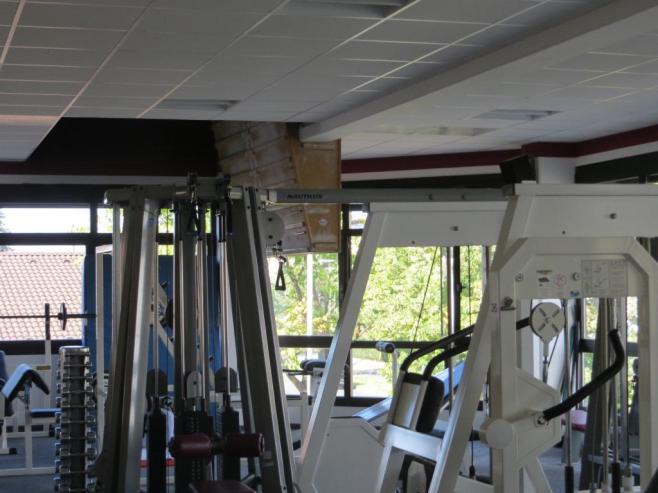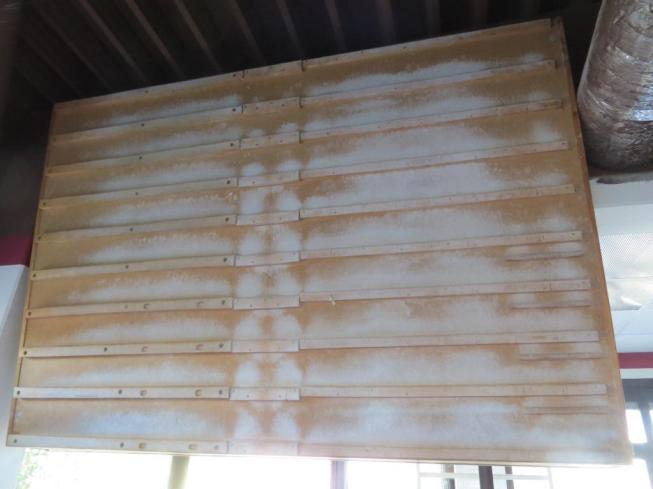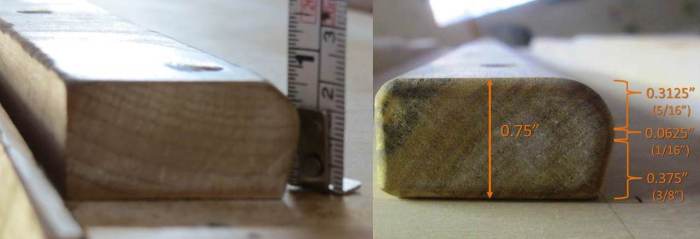by Mark Anderson
As soon as Kate and I committed to a trip to Germany, I started looking for information on “The Campus Center”, the birthplace (and namesake) of the Campus Board. Legend has it that Wolfgang Gullich was looking for a new way to train explosive power for a new cutting-edge route he was trying in the Frankenjura. He developed a ground-breaking new training tool that would allow him to apply the concepts of plyometric training to climbing. The “Campus training” worked, Wallstreet was born (the first 5.14b or 8c in the world) and the rest is history. [read more on this here]
My obsession with campus training, and in particular, campus board specifications, is well-documented. I absolutely had to get a look at the original campus board, if it was still in existence. At the very least, I wanted to take a few measurements, especially rung-spacing, rung depth, and the angle of the board (steepness). It was a long shot, but it was worth looking into.
The Campus Center was an upscale fitness center for regular people (not a climbing gym), located in Nuremberg, Germany. We just so happened to be flying in and out of Nuremberg, so if it was still standing, I was going to find it. One of my early climbing partners Bobby Gomez once called me a “climbing detective” for my persistence in uncovering all manner of random historical trivia and beta about various climbing objectives. I put all my powers to the test and (after a few missteps) entered “The Campus Center Nuremberg Germany Wolfgang Gullich” into my Google Machine. This is what I found.
Not only did the Campus Center still exist, they have a website, including a page dedicated to the Campus Board, with pics of Wolfgang Gullich and Action Directe! This was going to be easy. They had a picture of the board in 2010, still intact, so there was a great chance the board would still be there when I arrived. Still, I was nervous. How long could a regular fitness studio possibly keep an old relic like this hanging around before someone decided to remodel?
Nuremberg is a town of roughly 500,000, located in the heart of Bavaria and roughly an hour from the heart of the Frankenjura. The Campus Center is located on the east side of town, in a commercial district with a variety of storefronts. After our flight landed on the morning of September 18th, we picked up our rental car and headed straight there. My quite-rusty German was going to get tested almost immediately.
While I was still in Denver I scripted a few lines using my phrasebook in the hope that I could explain my intentions to the Campus Center personnel. Things like “I would like to see the Campus Board” (“Ich mochte das Campusboard gesehen”) and whatnot. I walked bravely through the automatic door, looked the gentleman at the desk square in the eyes, chickened out and mumbled “Sprechen sie English?” Yes, a little. I explained why I was there. He was not surprised. I was lead upstairs and introduced to another gentleman who spoke fluent English. Clearly I was not the first foreigner to make this pilgrimage. Still, it was also not an everyday event, and he was quite curious to know where I was from and why I was so interested. He led me down the hall and into a large room filled with modern-day Nautilus workout equipment. There, at the far end of the room, suspended from the ceiling, was the original Campus Board. I asked if it was still original, if it had been moved or altered in any way. He confirmed that it was all original. It certainly looked original, and comparing the video of Gullich using the board (above) to my photos further confirms that it hasn’t been moved.
The wood was glassy and polished. It had clearly been here for quite a long time. On the front side were rungs of three different depths running from bottom to top, and the four lowest of the largest rungs had pairs of two-finger pockets roughly carved into them. All three sets of rungs were spaced at the same interval. The medium-depth rungs had a big, slopey radius on them, and the shallowest rungs were slightly incut with a moderate radius. They looked very similar in shape to the Metolius small campus rungs. The rungs were much wider than Metolius rungs, and vertical lines had been drawn on the rungs in black marker, presumably to measure horizontal or diagonal (typewriter-style) moves.
On the back side was an old hangboard, and an even older set of hand-made wood holds cobbled together in the shape of a pseudo-hangboard. Was this the world’s first hangboard? It wouldn’t surprise me. [Note: the “cobbled together pseudo-hangboard” was built by Jerry Moffatt so he could train on trips. He eventually bolted it to the back of the Campus Board when he was living in Germany. Source] There were also some sloping, quarter-cylinder rungs on both the front and back of the board that looked like they’d been added more recently.
Once we got talking my escort shared all kinds of interesting details. The board was still used by climbers in the area. He showed me a sequence between a set of pockets and said that was the first move of Action Directe, and so on.
I took a bunch of pictures, posed for a pic in front of the board, and then I think I set myself apart from the other pilgrims when I pulled out my tape measure and inclinometer 🙂 I explained how much things like steepness and rung-spacing make a difference, and the value of comparing the configurations of different campus boards with the original. He understood but I suspect he thought I was taking things a bit too far 🙂
My first measurement was puzzling: 63.5 centimeters from the top of the first rung to the top of the fourth. I also measured the distance from the top of the second rung to the top of the first: 23.5 cm. That doesn’t make sense. I stood back and noticed the spacing between the first and second rungs was larger than the rest of the spacing. This is partially because the first row of rungs was aligned (“justified”, if you will) along the bottom edge of the rung, and the rest were aligned along the top edge. Upon further inspection I realized the spacing between rungs 2 thru 10 was 20cm per rung (on center, or from top edge to top edge), with the spacing between the first two 23.5cm. According to Jerry Moffatt’s book, Wolfgang Gullich was able to do 1-5-8 using only his two middle fingers. Presumably that was done on this board, so his 1-5 was 84cm and his 5-8 was 60cm (and his 1-8 has 144cm). That is insane! I can’t even deadhang a small Metolius rung with my two middle fingers.
I measured the rung depth: 2cm, which confirms Jerry Moffat’s recollection from his autobiography Revelations. That’s within a millimeter of .75 inches (the depth of a Metolius small rung). The depth of the carved pockets was also 2cm. The angle of steepness appeared to be about 12 degrees. It was hard to be certain since I didn’t have a level with me, but I think it’s in the ballpark. I had previously guessed the angle was 11 degrees from analyzing old photos of the board, so I think that’s pretty close.
In its current state, the Campus Board is really slick and polished. I’ve heard people say that wood becomes more textured over time, as the soft pulp wood wears away and the tougher grain becomes exposed. That may be true to a point, but there’s also a point where it just gets so polished it’s almost like glass. I’m really glad this board hasn’t been altered for the purpose of preserving its historical value, but I wouldn’t want to train on it!
In conclusion, the key specs of the Original Campus Board are 20-cm rung spacing, and 12-degrees overhanging. If you use small Metolius rungs you’ll be close-enough in terms of rung size and shape (the Metolius small rungs are slightly shallower). I’m really glad to have this data point, however, I would still recommend using “Moon-spacing” (22cm on center). I think at this point Moon Spacing is much more established and universal, at least in the English-speaking world, even if it’s not original. Using Moon Spacing doesn’t change the fact the Wolfgang Gullich was insanely strong, which I was able to confirm every time I tried one of his routes! I’m really happy I took the time to track down the Campus Center. Seeing the original Campus Board in all its glory was well worth the effort and one of the highlights of my trip.












Fascinating, and cool that you made the effort. The version of the story I had previously heard was that it was in the university gym at Erlangen, and “campus” derived from that.
Cafe Kraft – a modern (very good) bouldering gym in Nuremberg – has a huge print of the Wolfgang one-finger campus picture right next to their campus board. Quite cool. You can see it in all the Gimme Kraft videos.
LikeLike
cool man! although, i am surprised you dont have an inclinometer app on your phone :). WG was a beast, i can’t even remotely imagine 2 finger campusing on the small rungs.
LikeLike
Lucky for me, I’m still proudly rockin’ my original flip phone. That said, had I known about such an app, I would have borrowed my wife’s Iphone.
LikeLike
You can use an iPhone as a level in the compass app!
LikeLike
Point of clarification on the Moon Campus Board standard: it is 12.5 degrees overhanging, correct?
LikeLike
Pingback: Campusboard Training 101 - von Will Anglin - vertical-riot.de